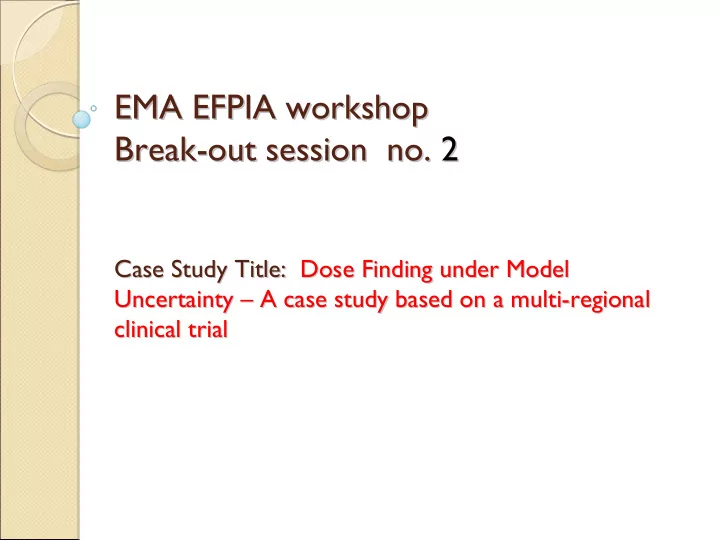

EMA EFPIA workshop EMA EFPIA workshop Break- -out session no. out session no. 2 2 Break Case Study Title: Dose Finding under Model Dose Finding under Model Case Study Title: Uncertainty – – A case study based on a multi- -regional regional Uncertainty A case study based on a multi clinical trial clinical trial
BOS2: Position statement M&S analysis results should be the primary analysis to establish the dose(s) for phase II/III
Background & Rationale Background & Rationale Case study COPD, Phase II, global development Endpoint: trough FEV 1 at week 2 (change from baseline) No prior PK/PD model Goal – Select dose to bring forward into Phase III Finding the right dose is not that simple True shape of dose-response model is typically unknown Choice of a working model may have a substantial impact on dose selection Model selection using observed data needs to account for model uncertainty and associated multiplicity issues
Objectives of the M&S work Objectives of the M&S work Primary objectives Proof of concept (PoC): any evidence of treatment effect Dose selection – which dose to take into phase III Incorporating uncertainty Design Dose levels investigated Sample size Analysis Adjusting for multiplicity Incorporating model uncertainty Exploring ethnicity effect (particularly Japanese)
Available Data / Prior Models After discussion with clinical team Placebo + 4 doses + active control Max treatment effect: 150 mL (improvement over placebo) Absolute clinically relevant differences ( � = 120 mL) Five candidate models
Methods – MCP-Mod Set of candidate models } • Optimize trial design: doses investigated Design • Investigate trial operating characteristics (including robustness and sensitivity) • Construct optimal contrast coefficients (PoC) Test dose-response signal (PoC) } Select dose-response model: model selection or averaging Analysis Possibly combined with external data Dose estimation (MED, EDx …)
M&S Assumptions M&S Assumptions True underlying DR is equally likely to be any of the five candidate models Japanese and non-Japanese share the same dose-response form
M&S Results – – M&S Results design design 4 active doses were chosen among 7 available operating characteristics were investigated
M&S Results – – M&S Results DR profiles DR profiles Weighted dose-response curves – based on the goodness-of-fit of 4 fitted models (linear, quadratic, emax and logistic)
M&S Results – – M&S Results dose selection dose selection Dose selected: 1 mg
Conclusions Conclusions Our approach emphasizes modeling/estimation (learning) as opposed to hypothesis testing (confirming) of the conventional approach Uncertainty was incorporated at both trial design and data analysis phases Evaluate operational characteristics of alternative designs and methods via simulation study to make recommendations on their use in practice
Generalisation Generalisation To ensure robust and sensible designs and analysis methods, modeling and simulations should be employed routinely Uncertainty should be accounted for decision making
Back- -up up Back
Recommend
More recommend